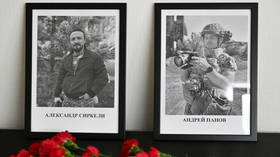US troops hold joint drills in Poland to ensure ‘unlikely attack from East even more unlikely’
US and Polish soldiers, alongside newly delivered American military hardware, have conducted joint drills as part of the biggest US deployment in Europe since the end of the Cold War.
Servicemen of the 3,500-strong 3rd Armored Brigade Combat Team, 4th Infantry Division, from Fort Carson, Colorado showcased some of their skills in front of Commander of the US Army Europe, Lieutenant General Ben Hodges, US Ambassador Paul Jones and Polish President Andrzej Duda said in Zagan on Monday.
The drills, which started at around 1:30 pm local time and lasted for about an hour, demonstrated US troops’ resolve to deter the “unlikely” potential aggression from Russia.
During the live fire exercises in Zagan, Polish-American forces split up into two teams. The task of the exercise was to stop the “enemy” advance from Zagan firing range over the distance of over 30 km to Zielona Gora. Leopard tanks from Poland’s 11th Armored Cavalry Division and the American Abrams tanks managed to repel the “enemy attack.” Anti-aircraft artillery and helicopters were also involved in the drill.
Iron Soldiers with their new partners! Less than 30 days and conducting live fire together! #StrongEuropepic.twitter.com/0YUXsry7Pp
— Sheryl Lyon (@CSMLyon) January 30, 2017
“The best way to make sure that there is never an attack [from Russia] and I believe it's unlikely, and the best way to keep it unlikely is to show a strong, deterrent capability,” Lieutenant General Hodges, told reporters.
Eighty-seven US battle tanks, 144 Bradley fighting vehicles, and 3,500 soldiers arrived in Europe earlier this month as part of NATO’s buildup near Russia’s borders, agreed at the NATO summit in Warsaw in July.
The arrival of American military equipment and personnel in Poland is another step in Operation Atlantic Resolve, a large-scale military undertaking the US launched in April of 2014, right after Crimea voted to be part of Russia.
The largest military buildup in Europe since the end of the Cold War was part of the Obama administration’s efforts to deter what it called growing ‘Russian aggression’ in Eastern Europe.
Moscow has repeatedly voiced concerns over such buildup. “These actions threaten our interests, our security,” President Vladimir Putin's spokesman Dmitry Peskov said earlier this month. “Especially as it concerns a third party building up its military presence near our borders.”
After the military exercises, the soldiers are to be distributed across Poland, Bulgaria, Romania, and the Baltic countries. The headquarters unit will be stationed in Germany.
“Poland will become the center of gravity for US operations in Europe,” Hodges told reporters. “We believe an attack from the east is unlikely, but it’s having troops on the ground here that makes it even more unlikely.”
"#Poland will become the center of gravity for U.S. Army operations in Europe" - General Hodges, @USArmyEuropehttps://t.co/yYMLkt44Ropic.twitter.com/KZBmBk49uq
— Embassy of Poland US (@PolishEmbassyUS) January 30, 2017
The deployment of 3,500 soldiers to Europe on a nine-month rotational basis comes at a time when the new US leader, Donald Trump has delivered mixed messages on NATO.
While calling the alliance “obsolete” in an interview days before his inauguration, Trump in a meeting with the British Prime Minister Theresa May last week confirmed American commitment to NATO.
Inauguration of bilateral military training between US 🇺🇸 & Polish 🇵🇱soldiers https://t.co/lgKLYJFoSV#StrongerTogether#ABCT#NATO 💪 pic.twitter.com/v8TULANVnP
— PLinNATO (@PLinNATO) January 30, 2017
The US president “confirmed he’s 100 percent behind NATO,” May told reporters last week following a bilateral meeting.
Trump has also spoken with other European leaders in Germany and France last week, with NATO featuring prominently during their discussions.
Trump committed to #NATO but would like to fight #ISIS with Putin https://t.co/QI2MaoVylT
— RT (@RT_com) January 27, 2017
“Our president has spoken with Prime Minister May, Chancellor Merkel and President Hollande and what I have heard is the affirmation of the importance of NATO and the United States commitment to NATO,” Hodges said of Trump's phone calls and May's trip to Washington.
At the same time, Trump, in a phone call with President Putin over the weekend, signaled that a new Russian – American partnership is possible following deteriorating bilateral relations during the Obama administration.
With uncertainty prevailing in European capitals over US commitment to NATO, Lt. Gen. Timothy Ray, deputy commander of US European Command, said the military is operating under the assumption that the American commitment will not be short-lived.
“Security in the United States begins with security in Europe,” he said, according to Stripes. “We intend to be here for quite some time.”
The US ambassador to Poland Paul Jones also voiced support for NATO’s deployment to Eastern Europe.
“We will deter and defend across the whole spectrum of conflict,” Jones said, pledging that the United States, Canada, and European allies will “defend every inch of alliance territory together.”
"Two World Wars and a Cold War have taught us stability in Europe is also important for the US" - NATO Secretary General @jensstoltenbergpic.twitter.com/Vfu1UhtnpZ
— BBC HARDtalk (@BBCHARDtalk) January 30, 2017
Polish President Andrzej Duda welcomed the US commitment. Calling the American troop deployment in Poland a “historic moment.”
“We welcome our allies here today with open arms,”Duda said.“I do believe that this presence is going to further strengthen the transatlantic bond and our collective security.”
Pododdziały 3. PBGB #ABCT przybyły do Polski i innych krajów regionu w ramach wzmocnienia wschodnich obrzeży #NATO. #AtlanticResolvepic.twitter.com/LdpmtfxEBL
— KancelariaPrezydenta (@prezydentpl) January 30, 2017
Meanwhile, the Polish Defense Minister Antoni Macierewicz sung the praises of the new US administration. “Today I know that Poland will not be threatened,” Macierewicz said. “God bless American President Trump.”















